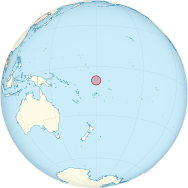Tuvalu, previously known as the Ellice Islands, is an island country in Polynesia in the Pacific Ocean. It consists of six atolls and three reef islands (islands made of rocks from coral skeletons), with a total land area of 26 km2 (10 sq mi). Its climate is hot and humid, with annual rainfall varying from 2,500–3,500 mm (98–138 in). The soil is very weakly developed, consisting mostly of coral sand and calcium carbonate-rich regosols. Vegetation on the islands predominantly consists of coconuts, screw palms, Casuarina, creepers, and grass, although some native forest exists. Previously, the islands were likely covered with Pisonia woodland.[1][2]
Thirty-seven species of birds have been recorded on Tuvalu, one of which has been introduced by humans. Thirteen of these species, nine of which are seabirds, breed in the country. The Pacific reef-heron, Pacific imperial-pigeon, and buff-banded rail, along with the introduced red junglefowl, are the remaining breeding species. Nine species of shorebird, eight species of seabird, mallards, and long-railed koels are migratory visitors to the islands.[3] Four species of birds found in Tuvalu are globally threatened; the bristle-thighed curlew, bar-tailed godwit, and gray-tailed tattler are near-threatened, while the Phoenix petrel is endangered.[4][5][6][7] Before the arrival of humans, the birds of the islands may have also included kingfishers, Acrocephalus warblers, Aplonis starlings, Prosobonia sandpipers, and fruit doves. However, higher sea levels at that time might have eliminated fresh water sources on most of the atolls, making them unsuitable for pigeons or starlings.[1]
This list's taxonomic treatment (designation and sequence of orders, families, genera and species) and nomenclature (common and scientific names) follow the conventions of the 2022 edition of The Clements Checklist of Birds of the World. The family accounts at the beginning of each heading reflect this taxonomy, as do the species counts found in each family account.
The following codes have been used to show several categories. Species without any tags are commonly occurring native species.
- (A) Accidental: a species that rarely or accidentally occurs in Tuvalu.
- (I) Introduced: a species introduced to Tuvalu as a direct or indirect consequence of human action.
- ^ a b Steadman, David W. (2006). Extinction & biogeography of tropical Pacific birds. Chicago: University of Chicago Press. pp. 282–283. ISBN 0-226-77141-5. OCLC 62172698.
- ^ Rodgers, K. A. (1991). "A brief history of Tuvalu's natural history" (PDF). South Pacific Journal of Natural Science. 11: 1–4.
- ^ Parr, John W. K. (2008). "Important bird areas of Tuvalu: Key sites for conservation". BirdLife International. Retrieved 2022-03-27.
- ^ BirdLife International (2017). "Limosa lapponica". IUCN Red List of Threatened Species. 2017: e.T22693158A111221714. doi:10.2305/IUCN.UK.2017-1.RLTS.T22693158A111221714.en. Retrieved 2022-03-27.
- ^ BirdLife International (2018). "Pterodroma alba". IUCN Red List of Threatened Species. 2018: e.T22698001A132618432. doi:10.2305/IUCN.UK.2018-2.RLTS.T22698001A132618432.en. Retrieved 2022-03-27.
- ^ BirdLife International (2020). "Numenius tahitiensis". IUCN Red List of Threatened Species. 2020: e.T22693182A181357867. doi:10.2305/IUCN.UK.2020-3.RLTS.T22693182A181357867.en. Retrieved 2022-03-27.
- ^ BirdLife International (2016). "Tringa brevipes". IUCN Red List of Threatened Species. 2016: e.T22693289A93394897. doi:10.2305/IUCN.UK.2016-3.RLTS.T22693289A93394897.en. Retrieved 2022-03-27.

